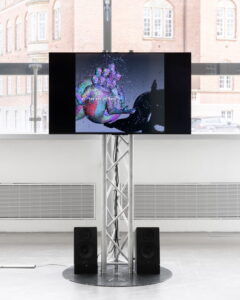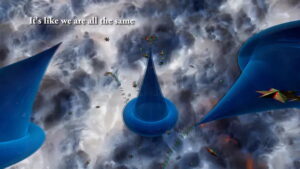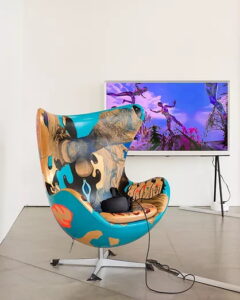Radar Contemporary, which is among the nominees for The BKF prize Artist-run Exhibition Venues of the Year 2021, is a virtual and physical exhibition platform with a focus on artists who work from a classical artistic point of view and implement new technologies in their practice.

Morehshin Allahyari: She Who Sees the Unknown: Ya'jooj Ma'jooj, 2017. ©Morehshin Allahyari and Radar Contemporary, ARoS Public. Photo: Mikkel Kaldal.
The platform arose out of a need to spread knowledge of art created with new technologies, both on the Danish art scene and in the general public, say the founders of Radar Contemporary, artists Ida Kvetny and Diana Velasco:
"We want greater focus on and recognition of these new art forms and media - and then we hope that we can open up contemporary art to a wider public via the digital communication options," says the two artists who established Radar Contemporary at the end of 2019 .
The platform thus started up at a time when the corona crisis meant the closure of museums and exhibition venues. And that gave the new artist-run initiative considerable attention already in its first year of existence:
"The closure of cultural life meant that we could show the great potential in our focus area on digital. Through their partially digital practice, the artists were able to show a great readiness for change, and this meant that many people opened their eyes to our online exhibition platform," says Ida Kvetny and Diana Velasco.
Art in a time of crisis
With Radar Contemporary, the two founders want to help document the revolutionary times we are in. It is about continuing to show the world from an artistic perspective and, among other things, examine the traces left by the corona era and what significance it has in relation to our perception of the body, the cosmos and approach to new technologies, they explain:
"We are concerned with what happens when you apply a new digital dimension to a physical work. What kind of dialogue occurs when you look at the latest technological expressions from different starting points? What does it do to our individual and collective memory, and what significance does it have for the artistic process?”

Lea Porsager: Spin Φ & Post-host: H@T, 2015. Radar Contemporary / Kunsthal Charlottenborg Art Cinema 2020. Still photo from art work. ©Lea Porsager.
Extensive exhibition activity
Radar Contemporary has had three exhibitions in the past year: Extensions Vol I, II and III.
Extensions vol I – Embodying the Digital – was exclusively online during the Covid-19 shutdown and resulted in great interest and over 2000 visitors online.
Extensions vol II – Cosmology – was a combination of an online exhibition and screening in Kunsthal Charlottenborg's Art Cinema with a live event that included a panel discussion with Helene Nymann and Ida Schyum as well as a music performance by musician and composer Jeanette Albeck and Nora Rosanes.
Extensions vol III – Monstrous Machines – was shown until mid-July at ARoS Public and on Radar's online platform. There has also been great interest here, with several articles and recommendations in the media and interest from the art and university community, say Ida Kvetny and Diana Velasco.
"The works for the exhibitions all stem from an investigation of what happens when our lives and art are transferred into the digital world. What does it do to us when technology becomes an extension of ourselves? What significance has Covid-19 had on our understanding of art and consumption of digital media? How does our digital presence affect our perception of the cosmos? And why is our reaction to technological development often characterized by fear?”

Ida Kvetny: DEMOS, 2021. ARoS Public. Photo: Mikkel Kaldal.
Artist-driven make new currents visible
Parallel to Extension's exhibitions, Radar shows online artist portraits, artist talks, panel debates and a podcast Radar Channel, as well as holding physical panel debates and other events.
Radar has also released one book with works by Danish and international artists, who work at the crossroads between art and technology. The book contains texts by contemporary art historians and curators who bring together the current Extension's exhibitions and themes.
The two artists behind Radar Contemporary feel that artist-run places have a central role in challenging and developing the artistic landscape:
"Especially during COVID-19, several artist-run exhibition venues have shown readiness to change and flexibility. Many have challenged conventional exhibition formats and have thereby reached a wider audience. We see that the artist-run places can help to ensure diversity in the art life and make visible new currents and talents that have not yet reached the more established institutions. In this way, they can have a burgeoning/stimulating and rewarding role in the art world and in society in general.”
When asked to name one concrete thing that could improve the conditions for artist-run places, they point to the contractual conditions in the self-organized part of art life:
"We could use access to standard contracts and minimum rates for artists and curators that are adapted to the often limited finances of artist-run venues."
The image at the top of this page: Monstrous Machines. Radar Contemporary / ARoS Public 2021. Diana Velasco: Face Lift, 2021. Kristoffer Ørum: Signal_Crayfish, 2019–2020. Installation photo: Mikkel Kaldal.

Andreas Refsgaard: Erasing/Enhancing. ©Ex Machina (2015), Universal Pictures. Radar Contemporary / ARoS Public, Monstrous Machines, 2021.